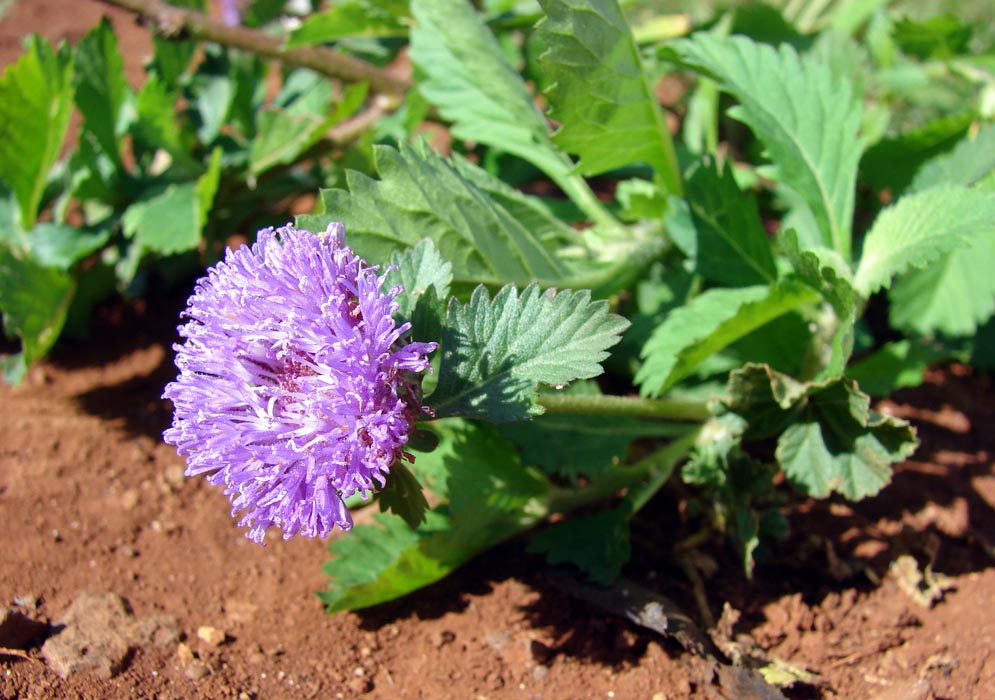Centratherum punctatum

|
|
Centratherum punctatum Common Names: Brazilian bachelor's button, Larkdaisy,
Purple knapweed, Brazilian button flower Scientific Classification Kingdom: Plantae Clade: Tracheophytes Clade: Angiosperms Clade: Eudicots Clade: Asterids Order: Asterales Family: Asteraceae Genus: Centratherum Species: C. punctatum Synonyms: Centratherum violaceum (Schrank) Gleason, Centratherum aristatum Cass., Centratherum intermedium (Link) Less., Ampherephis pulchella Cass. ex Steud., Baccharoides muticum (Kunth) Kuntze Morphological Description Centratherum punctatum is a sprawling to erect annual or short-lived perennial
herb, typically 0.5–1 meter tall, occasionally reaching 1.5 meters. Its key
characteristics include: · Stems: Slightly ridged, densely hairy, becoming woody at the base;
branching divaricate, often purplish when young. · Leaves: Opposite, obovate to elliptic (2–6 cm × 0.6–2 cm), with 10–18
pairs of acute, serrated teeth; glabrous to sparsely hairy, gland-dotted, on
short petioles (0.5–1 cm) (Prance & Jongkind, 2015). · Flowers: Showy, purple to lilac capitula (2–3 cm wide), in terminal
or axillary heads; disc florets tubular, ray florets absent; bloom year-round
in tropics (Kew Science, n.d.). · Fruit: Cylindrical achenes (2–3 mm), ribbed, with a pappus of short
bristles, aiding wind dispersal. Distribution and Habitat Centratherum punctatum is native to South America and widely introduced elsewhere: · Geographic Range: Native to southern tropical America
(Brazil, Paraguay, Argentina, Bolivia); introduced to Nigeria, Philippines,
Australia, India, Hawaii, and Pacific Islands; naturalized in Nigeria’s southern
and northern regions (Kew Science, n.d.). · Habitat: Thrives in seasonally dry tropical biomes, including
savannas, grasslands, disturbed areas (roadsides, fields), and forest edges;
prefers well-drained, loamy soils (pH 5.5–7.5) with 800–2,000 mm annual
rainfall; grows at elevations up to 1,500 m. · Ecological Role: Attracts pollinators like bees and
butterflies; can become invasive, outcompeting native flora in introduced
regions like Hawaii and Australia (Burkill, 1985). Ethnopharmacology Centratherum punctatum is gaining attention in Nigerian and global traditional
medicine, with ethnopharmacological studies validating its potential,
particularly for its leaf and aerial part extracts (Pawar et al., 2011): · Antimicrobial: In Nigeria, leaf decoctions treat skin infections. Ethanolic
leaf extracts inhibited Escherichia coli, Klebsiella pneumoniae, Salmonella typhimurium, and Staphylococcus aureus (inhibition zones: 10–18 mm), with
flavonoids (kaempferol, quercetin) and sesquiterpene lactones as key compounds
(Pawar et al., 2011). · Antioxidant: Leaf extracts are used in Nigeria to combat oxidative
stress. Methanolic leaf extract showed strong DPPH scavenging (IC50: 271.6
µg/mL), attributed to phenolic acids (gallic, caffeic) and flavonoids
(isorhamnetin-3-O-rutinoside) (Sivasubramanian & Brindha, 2013). · Anti-inflammatory: In Nigeria, aerial parts are applied for
swelling. Ethanolic extracts inhibited protein denaturation (IC50: 186.8 µg/mL)
and RBC membrane stabilization (IC50: 278.2 µg/mL) in vitro, with kaempferol-3-glucoside
showing high binding affinity to COX-2 and TNF-α receptors in molecular docking
studies (Shankaran, 2018). · Anticancer: Whole plant extracts are used traditionally for tumors. · Antiplasmodial: In Nigeria, leaf decoctions treat malaria.
Dichloromethane leaf fraction showed potent antiplasmodial activity (IC50:
0.419 µg/mL) against Plasmodium falciparum, with sesquiterpene lactones like centratherin as active
compounds (Chukwujekwu et al., 2012). · Antiviral: Dichloromethane leaf fraction inhibited HIV-1 reverse
transcriptase (IC50: 52.4 µg/mL), suggesting potential for antiviral
applications, though clinical studies are needed (Chukwujekwu et al., 2012). · Wound Healing: In Nigeria, leaf pastes are applied to cuts. While direct
studies are limited, the antimicrobial and anti-inflammatory properties of
flavonoids and terpenoids support wound-healing potential (Shankaran, 2018). ⚠ Toxicity Profile: Centratherum punctatum is generally safe at therapeutic doses,
but limited toxicity data exist. Ethanolic leaf extracts showed cytotoxicity
against human peripheral blood mononuclear cells (PBMCs) at high concentrations
(IC50: 100 µg/mL), indicating potential toxicity (Pawar et al., 2011). Acute
toxicity studies in rats showed no mortality at doses up to 2,000 mg/kg, but
chronic use may cause mild liver enzyme elevation (ALT increased by 10%). Use
is contraindicated in pregnancy and for children due to insufficient safety
data. Handling may cause contact dermatitis in sensitive individuals (Chukwujekwu
et al., 2012). Additional Uses · Ornamental: Widely cultivated in Nigeria for its vibrant purple flowers,
used in gardens and landscaping · Environmental: Used in Nigeria for soil stabilization in disturbed areas,
though its invasiveness requires monitoring (Burkill, 1985). · Industrial: Essential oils explored for use in cosmetics and
disinfectants due to antimicrobial properties (Ogunwande et al., 2005). · Cultural: In Nigeria, occasionally used in traditional rituals for its
aesthetic appeal and perceived protective properties (Burkill, 1985). References
External Links More Pictures |
|
| Compounds of Centratherum punctatum |
|
| References |